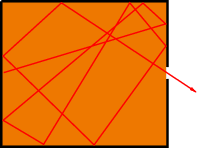
In the 19th century there was a lot of interest in thermodynamics. One of the areas of interest was the rather contrived idea of a black body: a material kept at a constant temperature T, and absorbing any radiation that falls on it. Thus all the light that it emits comes from its thermal energy, non of it is reflected from other sources. A very hot metal is pretty close to this behaviour, since its thermal emission is very much more intense than the environmental radiation. A slightly more realistic device is an oven with a small window, which we need to observe the emitted radiation, see Fig. 1.1. The laws of thermal emission have been well tested on such devices. A very different example is the so-called 3 K microwave radiation (Penzias and Wilson, Nobel price 1978). This is a remnant from the genesis of our universe, and conforms extremely well to the black-body picture, as has been shown by the recent COBE experiment, see Fig. 1.2.
The problem with the classical (Rayleigh-Jeans) law for black-body radiation is that it does suggest emission of infinite amounts of energy, which is clearly nonsensical. Actually it was for the description of this problem Planck invented Planck’s constant! Planck’s law for the energy density ate frequency ν for temperature T is given by
|
ρ(ν,T) = {8πh\over
{c}^{3}} {{ν}^{3}\over {
e}^{hν∕kT} − 1}.
| (1.2) |
The interpretation of this expression is that light consists of particles called photons, each with energy hν.
If we look at Planck’s law for small frequencies hν ≪ kT, we find an expression that contains no factors h (Taylor series expansion of exponent)
|
ρ(ν,T) = {8π{ν}^{2}kT\over
{c}^{3}} .
| (1.3) |
This is the Rayleigh-Jeans law as derived from classical physics. If we integrate these laws over all frequencies we find
|
E ={\mathop{ \mathop{\mathop{∫
}\nolimits }}\nolimits }_{0}^{∞}dνρ(ν,T) = {8{π}^{5}{k}^{4}\over
15{c}^{3}{h}^{3}}{T}^{4}
| (1.4) |
for Planck’s law, and infinity for the Rayleigh-Jeans law. The {T}^{4} result has been experimentally confirmed, and predates Planck’s law.